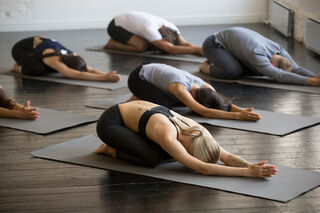Coronavirus Disease 2019
Yoga and Meditation, Sensory Health, and COVID-19
Two leading experts propose adjunctive interventions.
Posted July 10, 2020 Reviewed by Ekua Hagan
By William C Bushell, Ph.D., Eddie Stern, and Maureen Seaberg
When oxygen levels in people’s blood drop dangerously low, they will usually become short of breath; they will likely become alarmed and seek emergency help.
However, in COVID-19, the virus often compromises the sensorium, the seat of the senses, so much that “silent hypoxia” occurs and victims have no idea they are in mortal danger.

We have found that practicing meditation and yoga could boost sensory health. And as if to underscore it, doctors are having success placing patients into a prone posture akin to the yoga asanas in order to improve their respiration.
Early in the COVID-19 pandemic, a task force was formed to advocate the practice of meditation and yoga as a potential adjunctive treatment for COVID-19, because of the significant anti-stress, anti-inflammatory, and immune-enhancing (including anti-infectious and antiviral) properties of these behavioral health modalities.
This task force, consisting of scientists from MIT, Harvard Medical School, the University of California, San Diego, and the Chopra Research Library of the Whole Health Institute, included infectious disease epidemiologists, one of whom has been affiliated with the Centers for Disease Control (CDC). The scientific model that was put forth by this team was just published in a peer-reviewed medical journal, and integrated voluminous scientific evidence demonstrating that meditation and yoga practices could potentially protect multiple organ systems of the body generally, including the respiratory system.
Now some of the authors of this article and some new ones are seeking to extend this original scientific model to explore how certain meditation and yoga practices may potentially be used to intervene in critical phases of the COVID-19 and whether they may even offer means of intervention that cannot be surpassed by other, standard, medical means.
In advanced respiratory disease states similar to COVID-19, blood oxygen levels progressively drop to dangerous levels, in the process producing aversive sensations resulting from acute difficulty breathing, known as dyspnea. Such sensations tend to intensify as oxygen levels continue to drop, resulting in a sense of suffocation or intense anxiety, and may progress to panic, delirium, and loss of consciousness, and then widespread tissue damage and death in the worst cases, unless emergency medical treatment is successfully applied.
Indeed, these sensations of alarm thereby “ideally” result in the obtaining of life-saving intervention. For reasons still unclear, and now the subject of intensive research, in COVID-19 disease, the declining oxygen levels do not always result in sensations leading to dyspnea, and consequently, many patients may experience symptoms similar to a mild cold with mild chest congestion, and yet then suddenly and precipitously oxygen levels drop to such an extent that widespread tissue damage and death may rapidly ensue.
Patients in such an advanced state of disease will be put on mechanical ventilators, a treatment that does not enjoy a high success rate, and frequently itself can lead to many problems, even including injury to patients. Earlier in the present pandemic, ICU and respiratory physicians discovered the silent hypoxia syndrome in a large number of patients through the continuous monitoring of oxygen levels of patients who had only mild symptoms of the disease, through a simple noninvasive device known as a pulse oximeter. These patients were not distressed and were relatively relaxed (leading to other terms, including “happy hypoxia” and “apathetic hypoxia”), talking on their cell phones, texting, watching television, and yet their oxygen levels were in many cases dangerously low and/or dropping precipitously.
Rather than place them on ventilators—which would have been the case if the patients were unconscious or requiring sedation for their psychological state—some doctors had the patients become prone, i.e., lie on their stomachs, in order to free up lung volume for access to increased respiratory function from the lower lungs, which is normally curtailed in the usual supine position. Remarkable increases in blood oxygen levels would often result rapidly from this “proning” maneuver, from levels as low as 50 to 70 percent back up to 90 percent levels and over (below 90 percent is considered low and concerning, with dangerous hypoxic levels extending on a spectrum below this), the maneuver often dramatically saving many patients from extensive hypoxic tissue damage, as well as death.
Although a relatively rare form of medical intervention, the benefits of proning for a number of medical conditions have been known at least for decades in Western respiratory and Intensive Care Unit medicine. Moreover, the value of the prone position in respiratory health has been known in the yogic sciences for centuries. In fact, while the utilization of proning for the COVID-19 pandemic is becoming more widespread and extremely helpful and life-saving in many cases globally, we believe that this fundamental procedure—which does have some limitations—could be significantly enhanced by the integration of certain other related yogic procedures along with it.
Specifically, prone yoga positions such as “balasana” and “makarasana” and certain restorative yoga postures, are frequently strategically suggested for both down-regulating the sympathetic nervous system contributions to stress, and for increasing the lung capacity in the back of the body (where we have a greater surface area of lung tissue) (Parker, Gail; Restorative Yoga for Ethnic and Race-Based Stress and Trauma. Singing Dragon: London, 2020). In addition, we believe that yogic techniques of slow, controlled nasal breathing could add benefit to yogic proning through the reduction in pro-inflammatory biomarkers, and through the production of nitric oxide.
Nitric oxide has been shown to be effective in improving arterial oxygenation in Severe Acute Respiratory Syndrome (SARS), and also in preventing tissue damage from SARS, which is, quite significantly, a viral disease closely related to COVID-19.
While this work-in-progress is outside the scope of the present context, it will become available soon, and in the meantime, we will briefly describe another dimension of this project which is of particular relevance for the sensorium.
As mentioned, the “silent” aspect of “silent hypoxia” represents, in one key sense, a limitation of the usual sensory channels involved in communicating a respiratory, medical problem to the afflicted individual, which usually would then ideally lead to the obtaining of treatment for the progressive respiratory crisis. In the contemporary hospital medicine-based case of COVID-19 discussed here, this intervention could include proning, in conjunction with the necessary monitoring of oxygen levels with the pulse oximeter, under the supervision of a knowledgeable medical person/physician.
However, there is a possibility that an individual may be able to overcome sensory barriers to the detection of hypoxia, and this is in fact the basis of training regimens in aviation and high altitude medicine in the Western medical context. And indeed, such interoceptive training is a major aspect of the yogic sciences: research on yoga practitioners has demonstrated that certain yoga practices can significantly enhance individuals’ sensory-perceptual access to the inner organs and inner milieu, including the respiratory system.
Furthermore, it is important to note that although the aversive experience associated with hypoxia can ultimately result in life-saving behavior by “signaling” the medical problem, such forms of aversive experience can in fact also lead, if too intense or extended, to actual tissue damage in the respiratory system as well as in the brain and nervous system. Most importantly, recent research on yoga practitioners has found, however, that such yogic interoceptive training can simultaneously result in enhanced interoception, and significantly decreased aversive or painful (nociceptive) sensation and experience, while at the same time apparently increasing the volume and connectivity of key regions of the cerebral cortex.
It is not unreasonable then, to hypothesize that such a combination of yogically generated traits may possibly thereby increase sensory awareness of potentially dangerous shifts in blood oxygen levels, while at the same time reducing potentially tissue-damaging, dysfunctional neurosensory reactions to inflammatory stimulation characteristic of advanced COVID-19 disease (Bushell, Stern, et al, in progress). From this new, preliminary perspective, it appears that the learning and refining of certain key yogic/meditational practices may effectively and appropriately enhance the function of the human sensorium in this landscape of COVID-19, providing considerable health-protective and optimizing benefits for a threat that, according to many current expert estimations, may yet be ongoing for some time to come; this is the present “preparedness” model taken by the authors.
Please check back on this column in order to see the next developments in this hopeful and exciting line of scientific modeling and research.
William C Bushell, Ph.D., is a biophysical/medical anthropologist for many years affiliated with MIT, as well as Harvard and Columbia. He is now Co-Director of the Chopra Research Library, Whole Health Institute, and has spent many years scientifically investigating meditational and yogic practices, including around the world.
Eddie Stern is an Ashtanga Yoga teacher, author, and lecturer from New York City. He has a passion for engaging in a multidisciplinary approach to furthering understanding, education, and access to yoga through technology, scientific research, collaboration, and encouraging diversity in all aspects of his work.




